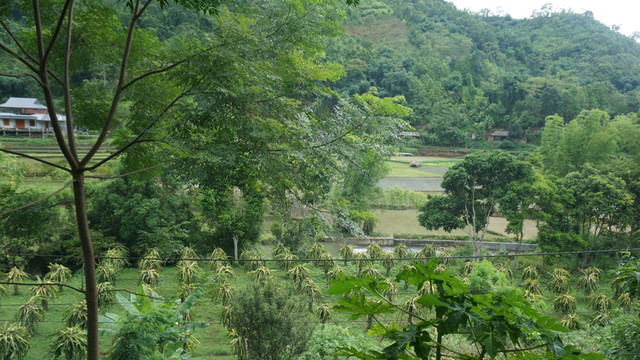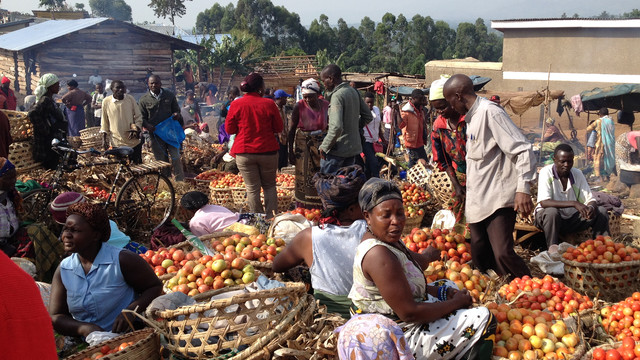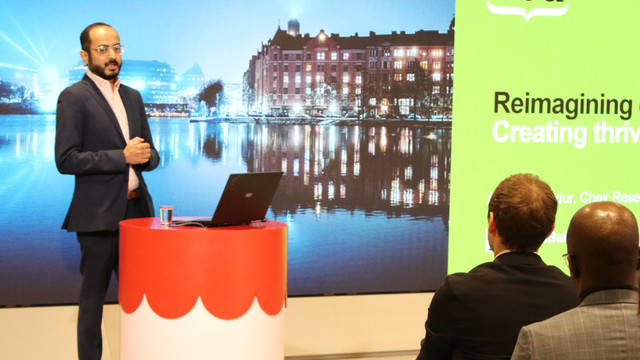Snapshots of a changing world – climate change impacts in Bangladesh
On a recent visit to Bangladesh, IIED director Andrew Norton saw first-hand the impacts of climate change and efforts to build resilience.


The people of southern Bangladesh are resilient and good at adapting to change: the most common vehicle in the city of Mongla is an electric rickshaw powered by a 12volt battery (Photo: Andrew Norton/IIED)
Visiting a country on the frontline of climate change, I saw communities displaced by the impacts of climate change, areas that are struggling with its effects and a town that is taking action to make a difference.
In Khulna City, a major urban centre in the south of the country and a gateway to the Sundarbans, the world's largest coastal mangrove forest and Bangladesh's great ecological treasure, a group of women told me how they had arrived there. Originally from Koyra Sub-District on the coast, they had been displaced in 2007, after Cyclone Sidr flooded their homes and left them without the freshwater they needed for drinking and domestic use.
"We all came together by boat," they said. "We came here because we had heard you could find cheap places to live. We carried what possessions we could. The people here gave us a lot of help."
Land erosion, salination of cropland and such dramatic weather events as storm surge in the wake of cyclones are displacing entire communities. All of these 'drivers' are amplified by long-term processes, notably sea level rise and reductions in freshwater reaching southern Bangladesh via the great rivers, the Ganges, the Brahmaputra and the Meghna, which run out to the sea through the coastal wetlands of Bangladesh.
The impacts of sea level rise are gradual but inexorable. By the 2080s, it is projected that a 65cm sea level rise will have caused 40 per cent of productive land to be lost in southern Bangladesh. Already about 20 million people in coastal areas are affected by salinity in drinking water.
Long tradition of resilience
The changes in this environment can be subtle as well as dramatic. Land can be gained as well as lost – although new land appearing from sedimentation tends to be less useful than old land that has been eroded. There is also immense resilience and a long tradition of adapting to environmental change.
#Gobeshona4 was a rich experience. Travelling tomorrow with @ICCCAD colleague Sarder to visit Khulna & the Sunderbans, visit displaced/climate migrant communities and see project work to help them adapt to climate impacts. #Bangladesh
— Andrew Norton (@andynortondev) January 12, 2018
New technologies for harvesting rainwater have helped many families adapt to a changing landscape without having to move, by providing a means to gather and store precious freshwater for the dry season. But it is clear that large numbers of people will have to move over the coming years.
Not all of the effects of displacement have been negative. The women I spoke to in Khulna were sanguine. Although some things were worse – their homes still flood periodically and their children have little space to play – some things are better.
Opportunities for income for men from rickshaw driving and for women from domestic work, trading or tailoring, are more diverse and reliable than their work before as day labourers and artisanal fishers. They also benefit from the support of a local NGO that provides credit and training.
A vision of a positive future
Saleemul Huq, director of the International Centre for Climate Change and Development (ICCCAD) in Dhaka and IIED senior fellow, is keen to change the narrative around climate displacement, building a vision of a positive and hopeful future.
One critical change would be to prevent the current pattern where many of those displaced by climate impacts end up sleeping on the streets of Dhaka. Even if they manage to graduate to finding slum housing, it is a brutal and dangerous transition. Instead, he argues, Bangladesh should build a network of at least a dozen climate-resilient, migrant-friendly secondary cities where incomers can build a new life.
If each city can welcome and provide security, livelihood, shelter and a new community to a million people, it will relieve pressure on the capital and future climate-induced migrants can move with dignity rather than under duress.
While in southern Bangladesh I had the opportunity to visit a town – Mongla – that is putting some of these ideas into action. Since the election of Mayor Zulfikar Ali in 2011 a huge amount of work has been done to make the town safe – and climate-resilient – for the estimated 150,000 people who live there. Previously the town, which is on the edge of the Sundarbans, was muddy, messy and highly vulnerable to flooding.
An impressive array of infrastructural works has transformed life there. These include raised roads and walkways, culverts and a system of rainwater harvesting that feeds two well-protected reservoirs. A water treatment plant provides safe water, which is piped to standpipes in the town.

Mongla should be able to cope well with whatever the climate throws at it for many decades to come. And the commitment to the safety and well-being of the town's population can be seen in other innovations, such as a public address system which can be used by the municipality and community organisations to communicate news and information.
Bangladesh's lowlands are one of the most climate-vulnerable environments in the world. But the commitment of local authorities, civil society, and on occasion the help of outside agencies (Mongla's transformation was locally-driven, but supported by international organisations ICLEI and the Rockefeller Foundation) shows that solutions can be found, and a better future built.
There is a role for research institutions too. The changes affecting the country's coastal lowlands, including the displacement of people, as well as salination of farmland and water sources, are complex and hard to measure, and the scale not properly understood. Understanding the nature of physical and social change will help generate the knowledge needed to underpin positive change.
Andrew Norton (andrew.norton@iiied.org) is director of IIED.


